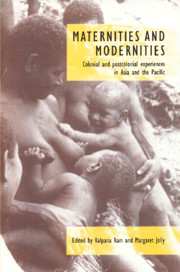Book contents
- Frontmatter
- Contents
- List of illustrations
- Notes on contributor
- Acknowledgements
- Map 1 Location of countries and regions in Asia and the Pacific discussed in this volume
- Introduction Colonial and postcolonial plots in histories of maternities and modernities
- 1 Shaping reproduction: maternity in early twentieth-century Malaya
- 2 Modernizing the Malay mother
- 3 ‘Good wives and mothers’ or ‘dedicated workers’? Contradictions of domesticity in the ‘mission of sisterhood’, Travancore, south India
- 4 Maternity and the story of enlightenment in the colonies: Tamil coastal women, south India
- 5 The dai and the doctor: discourses on women's reproductive health in rural Bangladesh
- 6 Other mothers: maternal ‘insouciance’ and the depopulation debate in Fiji and Vanuatu, 1890–1930
- 7 Just add water: remaking women through childbirth, Anganen, Southern Highlands, Papua New Guinea
- 8 From sisters to wives: changing contexts of maternity on Simbo, Western Solomon Islands
- Epilogue Maternal experience and feminist body politics: Asian and Pacific perspectives
- Index
5 - The dai and the doctor: discourses on women's reproductive health in rural Bangladesh
Published online by Cambridge University Press: 06 July 2010
- Frontmatter
- Contents
- List of illustrations
- Notes on contributor
- Acknowledgements
- Map 1 Location of countries and regions in Asia and the Pacific discussed in this volume
- Introduction Colonial and postcolonial plots in histories of maternities and modernities
- 1 Shaping reproduction: maternity in early twentieth-century Malaya
- 2 Modernizing the Malay mother
- 3 ‘Good wives and mothers’ or ‘dedicated workers’? Contradictions of domesticity in the ‘mission of sisterhood’, Travancore, south India
- 4 Maternity and the story of enlightenment in the colonies: Tamil coastal women, south India
- 5 The dai and the doctor: discourses on women's reproductive health in rural Bangladesh
- 6 Other mothers: maternal ‘insouciance’ and the depopulation debate in Fiji and Vanuatu, 1890–1930
- 7 Just add water: remaking women through childbirth, Anganen, Southern Highlands, Papua New Guinea
- 8 From sisters to wives: changing contexts of maternity on Simbo, Western Solomon Islands
- Epilogue Maternal experience and feminist body politics: Asian and Pacific perspectives
- Index
Summary
Women in Western countries have been struggling for several decades against what is now widely viewed as the unnecessary and excessive medicalization of childbirth. The move to a less interventionist model for childbirth has been a genuine gain for many women in the West (see Martin 1987; Oakley 1986), but there is a real risk of mythologizing and romanticizing the process of ‘natural childbirth’ and of projecting this image on to a Third World context where it is not always appropriate.
World Health Organization (WHO) policy for some years has emphasized working through traditional birth attendants (TBAs) as the best path to improving the appalling level of maternal and child mortality and illness in much of the Third World (see pp. 166–7 below). Recently, some doubts as to the universal appropriateness of this strategy have begun to surface (e.g. Scheepers 1991 for Yemen; Stephens 1992 for Andhra Pradesh). My own material on childbirth in rural Bangladesh suggests that we need to examine the concept of the TBA in more critical detail. It is too easy, perhaps, to counterpose the midwife to the doctor, seeing the former as a repository of traditional wisdom and the latter as a projection of patriarchal intervention. In practice, both may have serious deficiencies in terms of delivering effective health care, and their effectiveness may be further compromised by the cultural and material situation within which they work. In this chapter we will see that neither the village midwife (the dai) nor the village doctor are really in a position to care effectively for birthing women.
- Type
- Chapter
- Information
- Maternities and ModernitiesColonial and Postcolonial Experiences in Asia and the Pacific, pp. 144 - 176Publisher: Cambridge University PressPrint publication year: 1998
- 21
- Cited by



